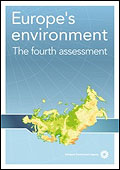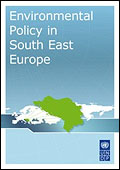
'Europe's environment — The fourth assessment'
By: European Environment Agency
The latest in a series of
assessments of the pan-European environment published over the past
15 years by the EEA, the report assesses environmental progress in 53
countries — an area with a total population of more than 870 million
people. The region includes: Eastern Europe, Caucasus and Central Asia
(EECCA), South Eastern Europe (SEE), as well as Western and Central
Europe (WCE). The report highlights priority areas such as:
Improved implementation of existing policies and the setting of
clear, realistic targets is a key recommendation of the report.
However, a shared environmental information system is also urgently
required to deal with a prevailing lack of reliable, accessible and
comparable environmental information across the pan-European
region.
Download the
report, its
executive summary, powerpoint and
flash presentations with the key messages.

Policies for a better environment — Progress in
Eastern Europe, Caucasus and Central Asia
By:
Organisation of Economic Cooperation and Development - Task Force for
the Implementation of the Environmental Action Programme for Central
and Eastern Europe
This is an assessment of progress in achieving the objectives of the
EECCA Environment Strategy since 2003 — focusing on actions taken by
EECCA governments. The report covers 12 countries.
The main message is that, in a still difficult context, the EECCA
countries have made some progress in improving environmental
management, but a major implementation gap persists. In an increasingly
diverse region, progress is not even across countries or environmental
policy areas. Finance is a barrier in all areas, but it is not always
the most important one: creating a more effective incentive structure
for environmental improvement through policy and institutional reform
is also essential.

Environmental policy in South East Europe
By: United
Nations Development Programme
This report reviews progress in the development and implementation of
environmental and sustainability policies in South East Europe (SEE), a
region which includes six countries and territories. It shows that
national environmental action plans and other sectoral strategies
dealing with the environmental dimension of sustainability have been
developed and adopted. New environmental legislation was adopted aiming
for compliance with EU directives and international agreements, but its
implementation is still in its early stages.
News
Document Actions
Share with others